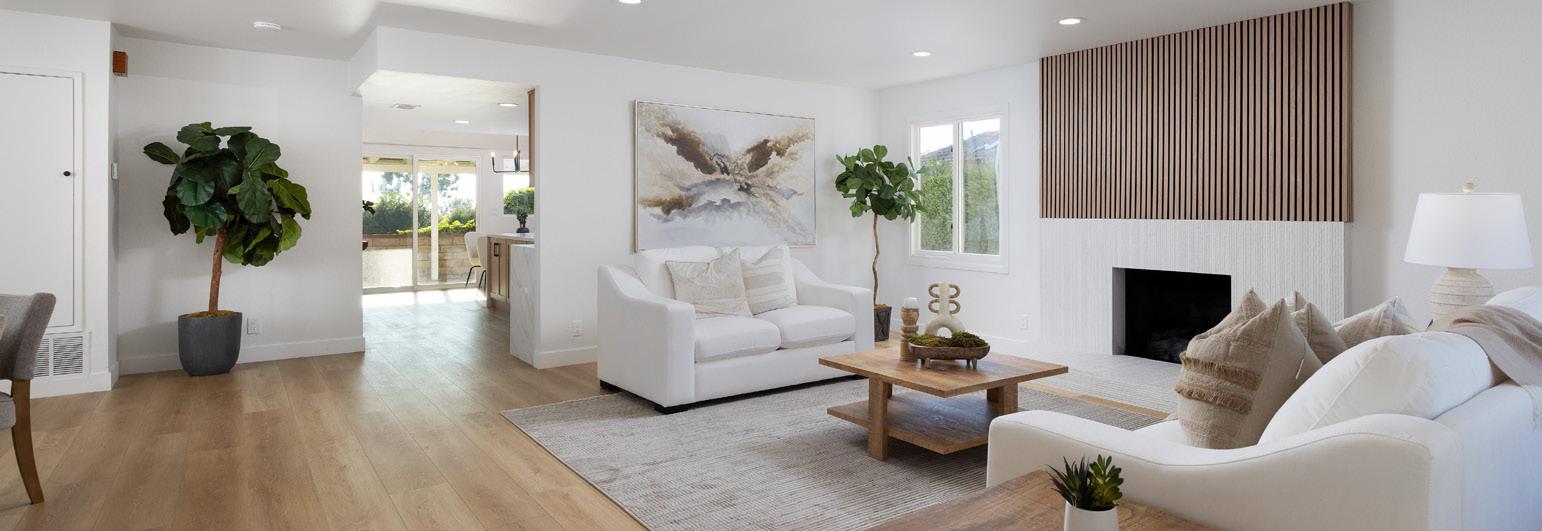



















Staging Furniture (If Needed)
Clearing Out Property
Property Improvements (Painting, Flooring, Electrical Work, Gardening, Etc)
Photography (Daylight, Twilight, Drone, Virtual Tour, Etc)
Print Media (Brochures, Amenities Lists, Flyers, Etc)
Digital Media (Social Media Ads, Email Marketing, Etc)
We can recommend vendors
Termite Inspection / Work (If Needed) We are happy to help!
We can recommend vendor
Fire Inspection (If Needed) We will schedule appointment
Property Repairs (If Needed)
Junk / Item Removal
We can recommend vendors
We can recommend vendors
We can recommend vendors
Staging
Photography
Print Marketing
On Market Date
Digital Marketing
First Showings / Open House
Escrow Opened
Inspection
Appraisal
Contingency Removal Deadline
Close Of Escrow
End Of Seller Possession
One of the most important steps in preparing your home for sale is staging. Simply put, staging helps your home look its absolute best—highlighting its strengths, downplaying any distractions, and helping buyers picture themselves living there. In today’s market, presentation matters more than ever, and a well-staged home can lead to faster offers and even a higher sale price.
In fact, homes that are professionally staged often sell quicker and for more money than those that aren’t. That’s because great staging does more than just make things look pretty—it creates a feeling. And buyers don’t just buy a property; they buy a lifestyle, a dream, and an emotional connection.
There’s no one-size-fits-all approach to staging. Depending on your home and your goals, we typically use one (or both) of the following types:
This type of staging is all about editing and optimizing your existing space. We’ll help you declutter, rearrange furniture, and remove personal items to make rooms feel more open and inviting. Sometimes it’s as simple as switching out a rug, taking down a few family photos, or moving a chair to create better flow. This kind of staging makes a big difference without needing to bring in new furniture.
If needed, we’ll bring in professional staging furniture and decor to breathe life into the space. By thoughtfully furnishing key areas—like the living room, primary bedroom, and dining space—we help buyers emotionally connect and imagine themselves living there. Strategic staging helps define how each space can be used and ensures your home photographs beautifully—both of which are key to capturing attention online and in person.
Once your home is fully prepped and staged, the next step is capturing it in the most compelling way possible. High-quality visuals are at the heart of our marketing strategy, because for most buyers, the first showing doesn’t happen in person—it happens online. That’s why we go far beyond just snapping a few photos. We create a full visual package designed to tell the story of your home and draw buyers in.
We start with professional daytime photography that highlights the natural light, layout, and best angles of each room. These images give buyers a clear sense of space and flow, and help your home shine across online platforms.
Next, we often include twilight photos—taken right at sunset—to give your listing a warm, welcoming glow. These shots are eye-catching and help your home stand out in a sea of daylight-only listings.
To showcase the full property, especially the exterior features and surrounding area, we offer drone photography. Aerial views are especially helpful for homes with large lots, unique landscaping, or great curb appeal—they provide a perspective buyers can’t get from the ground.
We also provide a Matterport 3D virtual tour, which allows potential buyers to “walk through” the home online, exploring each room at their own pace. This tool is especially powerful for out-of-town buyers or anyone who wants a deeper look before scheduling a showing.
Finally, we include detailed floor plans to help buyers understand the layout, room dimensions, and flow of the space. It’s one more way we make your home easier to visualize—and easier to fall in love with.
To make sure everything looks picture-perfect on photo day, you’ll want to tidy up countertops, turn on all lights, open blinds, and make sure each room is clean and clutter-free. Think of it as setting the stage one final time before the spotlight turns on. We will always be present to ensure everything is picture perfect, but a little prep goes a long way in helping your home shine both online and in person.
“Homes with high-quality photography sell 32% faster than homes with lower-quality visuals.” -Redfin
Once your home is staged, photographed, and ready to go, the next major step is entering it into the Multiple Listing Service (MLS)—the central hub of real estate marketing. This is where we create your home’s official listing, and it’s one of the most important parts of the entire selling process.
The MLS is not just where agents search for homes—it’s also the source of information that feeds to all the major real estate websites like Zillow, Redfin, Realtor.com, and hundreds of others. That means the quality of what we input here has a direct impact on how your home looks everywhere online.
We start by carefully entering all the key details of your property: square footage, number of bedrooms and bathrooms, lot size, year built, school district, upgrades, special features, and more. The MLS provides dozens of checkboxes and fields, and we make sure each one is filled out accurately so your home appears in as many relevant searches as possible.
Then comes the written description. The MLS allows up to 2,500 characters, and we work hard to maximize every word. This is where we highlight your home’s best features, paint a picture of the lifestyle it offers, and create a compelling narrative that encourages buyers to schedule a showing. It’s not just about listing the facts—it’s about selling the experience of living there.
We also include showing instructions, which tell buyer’s agents how and when the home can be viewed. Whether it’s by appointment only or during an open house, we make it simple and clear so that scheduling is smooth and efficient.
Finally, all of the photos, videos, 3D tours, and floor plans are uploaded to the MLS listing. From there, they’re automatically syndicated across online platforms, reaching thousands of potential buyers within the first 24 hours.
In short, the MLS is the engine that powers your home’s exposure—and we make sure it’s firing on all cylinders.

Once your home is listed, our job shifts to making sure it gets seen by the right people, in the right places, at the right time. That’s where our comprehensive marketing strategy comes in. We combine both digital and print marketing to maximize exposure and attract serious buyers.
Today’s buyers are online—and that’s exactly where we meet them. We use targeted digital marketing to generate buzz, create urgency, and keep your home top-of-mind across multiple platforms.
• Email Blasts to Agents: We send professionally designed email campaigns to thousands of local real estate agents to let them know your home is available. These emails highlight the key features, photos, and showing details to encourage them to bring their buyers through.
• Emails to Interested Buyers: We also reach out directly to buyers in our network who have searched for or inquired about similar homes. These are people actively looking—and your home might be exactly what they’ve been waiting for.
• Social Media & Digital Ads: We promote your listing through targeted social media ads, reaching people who have shown interest in the local market or homes like yours. This includes Facebook and Instagram Ads, allowing us to put your home in front of a wide audience.
While digital is essential, print still plays a big role—especially when it comes to connecting with people in the surrounding area.
• Direct Mail Flyers: We send professionally designed flyers to nearby neighborhoods to let locals know your home is for sale. Sometimes a neighbor, friend, or family member is the one who brings the perfect buyer to the table.
• Custom Property Brochures: We create high-end brochures that highlight the best features of your home, using beautiful photography, detailed descriptions, and clean, elegant design. These are available at showings and open houses to leave a lasting impression.
• Amenities Lists: Included in our brochures, these detailed lists highlight the upgrades, renovations, and special features that may not fit into the online listing. From new HVAC systems to smart home technology or custom finishes, the amenities list helps communicate the true value of your home and reinforces your asking price with clear, tangible improvements.
• Lifestyle Flyers: We also design flyers that showcase the neighborhood—local schools, restaurants, parks, coffee shops, and other nearby conveniences that make your location special. Buyers don’t just want to love the home—they want to love the community, too.
“In real estate, it’s not just location—it’s exposure.” -Unknown
Once your home is listed and generating interest, it’s time to welcome buyers in. Showings give them the chance to experience the space in person—to walk the layout, feel the light, and start picturing life there. These moments are often when real connections (and real offers) begin.
You’ll receive advanced notice for all appointments, and we’ll work with you to set showing windows that fit your schedule. We use secure platforms like ShowingTime to make scheduling easy and flexible. Our team manages everything behind the scenes, so you never have to worry about logistics.
Before each showing, a little prep goes a long way. We recommend:
• Turning on all lights
• Opening blinds to let in natural light
• Tidying surfaces and removing clutter
• Securing pets and personal items
Buyers usually feel more at ease when the seller isn’t home—it gives them space to explore and imagine themselves living there.
Your safety and peace of mind matter. Every showing is accompanied by a licensed agent, and access is managed through a lockbox system that tracks all visits. Whenever possible, we do our best to be present at showings—both to protect your home and to answer questions that help buyers fall in love with it. We also follow up with agents afterward to gather feedback and keep you informed.
In addition to scheduled appointments, we may also recommend open houses to maximize exposure—especially during your first weekend on the market. These events can bring in multiple potential buyers at once and generate excitement and urgency.
Private showings, on the other hand, allow buyers to take their time and ask detailed questions through their own agents. We’ll use a strategic mix of both to make sure your home is seen by the right people in the right setting.
Once showings generate strong interest, the next step is reviewing offers. This is where things get exciting—and where strategy becomes essential! Whether you receive one offer or several, we’re here to guide you through the process with clarity and confidence.
Each offer includes more than just a price. Terms like contingencies, deposit amounts, loan types, timelines, and seller requests can vary widely. To help you make the most informed decision, we create a detailed offer overview that breaks everything down side-by-side. We’ll walk you through every detail so you understand the strengths and potential trade-offs of each offer.
Not ready to accept as-is? We can negotiate. There are two types of counter offers:
• Single Counter Offer: Used when responding to just one buyer. We outline the specific terms we’d like to change—such as price, escrow period, or contingencies. If the buyer accepts, we go into escrow.
• Multiple Counter Offer: Used when multiple buyers submit offers. Buyers don’t see each other’s terms, and they don’t know how many other offers were made. After receiving responses, you choose the final offer to accept. It’s a great tool when you want to keep options open while encouraging stronger terms.
Most offers come with a built-in expiration—typically within three days. In competitive markets, we may set a formal offer deadline to give all interested buyers a fair shot. This can drive urgency and promote stronger, more competitive terms—especially when multiple offers are likely.
Our role is to make the offer process clear and strategic. We’ll ensure you understand every option so you can choose the one that’s right for you.

Not all offers are created equal. While price is a major factor, there are many other terms that can impact your bottom line, your timeline, and your overall experience as a seller. That’s why we look at the full picture—and help you do the same.
We build an easy-to-read offer summary sheet that lines up every important detail side-byside so you can compare terms clearly and confidently. Here are some of the key components we evaluate:
• Escrow Length: How long the buyer needs to close. (30 days is standard)
• Good Faith Deposit: The upfront amount the buyer is putting down (typically 3%)
• Contingency Timelines: These include inspection, appraisal, and loan—standard is 17 days for each, but shorter timelines are often more favorable to sellers.
• Contingent Property: Is the buyer relying on the sale of another home before closing on yours?
• Possession Terms: Will you hand over the keys at closing or is post-close occupancy
• needed?
• Home Warranty: Is the buyer asking for a seller-paid warranty, and what’s the cost cap?
• Included Items: What’s staying with the house—appliances, fixtures, furniture?
• Agent Concessions: Some buyers request a credit toward closing costs—either as a dollar amount or a percentage.
• Effective Price: This is your true net offer, factoring in concessions, credits, and other terms.
A contingency is a built-in protection for the buyer that gives them the right to cancel the deal under certain conditions—without losing their deposit. The most common contingencies are:
• Inspection: Allows the buyer to back out or renegotiate if the home inspection reveals issues.
• Appraisal: Ensures the home appraises for at least the purchase price (especially important with loans).
• Loan: Gives the buyer time to secure final mortgage approval.
• Sale of Another Property: If the buyer needs to sell their current home before closing on yours.
Contingencies are important—but they also carry risk. Longer timelines or too many contingencies can weaken an offer or delay your sale. Shorter or waived contingencies are typically stronger from a seller’s perspective, because they move the transaction forward faster and with more certainty.
Once you’ve accepted an offer, your home enters escrow—a neutral period where all the agreed-upon terms are carried out and the final details are handled. While it might feel like the hard part is over, there’s still important work happening behind the scenes to make sure your sale closes smoothly.
Escrow is a secure, third-party process that protects both the buyer and the seller during the transaction. An independent escrow company holds funds, documents, and instructions while ensuring that all conditions of the contract are met before the sale is finalized.
Every escrow is a little different, but here’s what typically takes place:
• Buyer’s Deposit: The buyer submits their good faith deposit, which is held in escrow until closing.
• Inspections & Repairs: The buyer conducts inspections. If any issues are discovered, they may request repairs or credits.
• Appraisal & Loan Approval: If the buyer is financing the purchase, their lender will order an appraisal and finalize loan approval.
• Contingency Removal: Once inspections, appraisal, and financing are complete, the buyer will officially remove their contingencies—making the sale much more secure.
• Final Walkthrough: Just before closing, the buyer does a final walkthrough to confirm the property is in the same condition as when they submitted their offer and any agreed-upon repairs have been completed.
• Signing & Closing: Both parties sign final paperwork. Funds are transferred, and once escrow confirms everything is complete, the home officially changes hands.
We’re with you every step of the way—tracking timelines, coordinating with escrow officers, staying in close contact with the buyer’s agent, and making sure no detail is overlooked. If any issues come up (and they sometimes do), we’ll guide you through solutions and keep the process on track.
Most escrows last around 30 days, but this can vary depending on the buyer’s financing, inspections, and other negotiated terms. We’ll keep you informed at every milestone so you know exactly where things stand.






Closing costs are the various fees and expenses due at the end of a real estate transaction. They cover everything from escrow services to title insurance and lender charges. While the exact amount depends on the property price, location, and terms of the deal, they typically range between 2% to 5% of the purchase price for buyers, and 5% to 8% for sellers, including commissions.
• Escrow Fees: Paid to the neutral third party that manages the transaction.
• Title Insurance: Protects against past ownership claims or title defects.
• Lender Fees: Includes underwriting, loan origination, and credit report costs.
• Appraisal Fee: Required by the lender to confirm the home’s value.
• Recording Fees: Paid to the county to officially record the new ownership.
• Prepaid Costs: Property taxes, interest, and homeowners insurance often need to be prepaid for the first few months.
• Homeowners Association (HOA) Transfer Fees: If applicable, for processing the new ownership in the HOA system.
• Agent Commissions: Usually 5%–6% of the sale price and pays for the buyer’s and seller’s agents.
• Escrow Fees: Often shared with the buyer, but negotiable.
• Title Insurance (Owner’s Policy): Protects the buyer and is usually a seller-paid cost in California.
• Transfer Taxes: City or county taxes applied to the change in ownership.
• HOA Document Fees: If your home is in an HOA, you may need to pay for document preparation.
• Outstanding Liens or Property Taxes: Must be settled at closing.

In some cases, buyers may ask for seller-paid credits to cover a portion of their closing costs. This is common in slower markets or when a buyer needs cash to close. These credits are negotiable and should be weighed against the overall strength of the offer.
When selling your home, honesty isn’t just the best policy—it’s the law. Disclosures are your opportunity to provide buyers with a transparent view of the property’s condition, history, and known issues. While it might feel overwhelming at first, making thorough and accurate disclosures can protect you from legal trouble down the road and help ensure a smoother sale.
In California (and most states), sellers are legally obligated to disclose certain facts about the property, whether or not they seem like deal-breakers. Here are some of the key items included in the disclosure process:
• Transfer Disclosure Statement (TDS): A comprehensive, state-mandated form where you disclose everything from roof leaks to appliance malfunctions.
• Seller Property Questionnaire (SPQ): Adds more detail to the TDS, covering improvements, repairs, past insurance claims, neighborhood nuisances, and more.
• Natural Hazard Disclosure (NHD): Informs the buyer if your property is in a zone prone to hazards like earthquakes, wildfires, or floods.
• Lead-Based Paint Disclosure: Required for homes built before 1978.
• HOA Information: If your home is part of a homeowner’s association, you’ll need to disclose CC&Rs, dues, rules, and any pending litigation or assessments.
• Known Issues: Any material facts you’re aware of that could impact value or desirability— past water damage, unpermitted work, pest problems, etc.
Being upfront builds trust and can actually prevent buyers from backing out later. Here’s how strong disclosures benefit you:
• Limits Your Liability: If something comes up after the sale, buyers can’t claim you hid it if you disclosed it.
• Reduces Renegotiation: Surprises late in escrow often lead to price reductions or delays. Proper disclosure sets realistic expectations early.
• Protects the Deal: Well-informed buyers are more confident and less likely to cancel.
We walk you through every disclosure document, step by step. We’ll explain what’s required, help you remember important details, and make sure everything is submitted completely and on time. If you’re not sure whether something counts—tell us. When in doubt, it’s better to disclose.
Once you’re in escrow, the buyer begins their due diligence—a period where they’re allowed to inspect the property and better understand what they’re purchasing. This process is common, expected, and an important part of creating a smooth, legally sound sale.
Buyers typically hire a licensed home inspector to examine the property. The inspector will look at all accessible areas and systems, including the roof, plumbing, electrical, HVAC, and structure. Afterward, they’ll deliver a detailed report—often 30+ pages long.
It’s important to know:
• Not everything in the report is a repair request.
• The inspector is simply calling out what they observe—not assigning blame or demanding corrections. The report will include everything from major safety issues to normal wear and tear and cosmetic notes.
If the buyer feels that certain items need attention, they can submit a Request for Repair. This is not a demand—it’s a negotiation. As the seller, you have options: agree to the repairs, offer a credit instead, or negotiate further. We’ll guide you through the request carefully, helping you focus only on what truly matters while protecting your bottom line.
As part of California’s disclosure requirements, both the buyer’s and seller’s agents must complete an AVID (Agent Visual Inspection Disclosure). This is where we document what we can visually observe about the property.
We’re not contractors or inspectors, so the language is often general—terms like “cracks observed,” “stains noted,” or “wear on flooring.” That’s intentional. We’re simply recording visible conditions, not diagnosing them.
It’s in your best interest to be transparent. Between the AVID, the buyer’s inspection, and your own disclosures, the buyer gets a full picture of the home. That clarity:
• Builds trust
• Reduces the risk of buyer remorse
• Helps protect you from legal issues down the road
A well-informed buyer is a confident buyer—and confident buyers close deals.
Our job is to help you disclose properly, respond strategically, and stay in control of the outcome. With the right approach, inspections don’t create problems—they prevent them.
Once you’re in escrow, two critical steps must happen to move the sale forward—appraisal and loan approval. These are key parts of most financed offers, and they help ensure that the buyer (and their lender) is confident in the value of your home.
If a buyer is using a loan, their lender will require an appraisal to confirm the home’s value matches— or exceeds—the purchase price. An independent appraiser is assigned to visit your property, assess its condition, and compare it to recent sales in the area.
• If the home appraises at or above the contract price, it’s full steam ahead.
• If it comes in below the purchase price, a few things can happen:
- The buyer can choose to cover the difference in cash.
- We can renegotiate the price.
- The buyer can cancel the contract if there’s an appraisal contingency in place. We prepare for this step well in advance by pricing strategically, highlighting upgrades, and providing comparable sales to support your home’s value.
At the same time, the buyer’s lender is working behind the scenes to finalize the mortgage. This includes verifying income, employment, credit, and assets. We stay in close communication with the buyer’s agent and lender to track progress and make sure all deadlines are met.
Once the appraisal is approved and the loan is fully underwritten, the buyer removes their loan contingency, bringing us one big step closer to closing.
We proactively manage this entire stage—coordinating access for the appraiser, staying in touch with the buyer’s team, and updating you on each milestone. If any issues arise, we’re ready with solutions and strategies to keep things on track.
“Appraisal and loan approval aren’t roadblocks—they’re checkpoints on the way to closing.”
The final walkthrough is the buyer’s opportunity to confirm that the property is in the agreed-upon condition before closing. It’s not a new inspection—it’s simply a chance to verify that everything is as expected.
• A brief, in-person visit to the property by the buyer (usually within 5 days of closing)
• An opportunity to ensure the home is in the same condition as when the offer was made
• A check to confirm that any agreed-upon repairs have been completed
• A great time for the buyer and seller to meet, if desired—to walk through how certain systems work (sprinklers, pool equipment, appliances) and share information on service providers like gardeners or pool maintenance
• All systems (plumbing, HVAC, electrical) are in working order
• No new damage or unexpected changes to the property
• Repairs that were requested and agreed upon have been made
• Agreed-upon items (like appliances or fixtures) are still in the home
• Not a time to bring up new repair requests
• Not a formal inspection
• Not required by law—but strongly recommended
• We coordinate access and accompany the buyer’s agent and the buyer
• We review and provide receipts and documentation for any agreed-upon repairs
• We help ensure a smooth, professional closeout of the sale

You’ve accepted an offer, navigated escrow, cleared inspections, and now—closing day is here. This is the final step in the process, where everything comes together and ownership officially transfers to the buyer.
• Closing occurs when the buyer’s lender funds the loan and escrow records the transaction with the county.
• Once recorded, ownership officially transfers, and the sale is complete.
• You’ll receive confirmation as soon as the recording is done.
Your proceeds from the sale are typically wired or available as a check on the next day escrow after closes. We’ll walk you through the options for receiving funds and ensure the escrow company has everything in place ahead of time.
Unless otherwise negotiated, possession typically occurs the day escrow closes. Sometimes, sellers remain in the home for a short period after closing. This is called “seller in possession” or a rent-back— and the terms are pre-agreed in the contract.
• Confirm all paperwork is signed and funds are received
• Communicate with escrow and title to track recording status
• Coordinate key exchange or lockbox removal
Closing day is a celebration—but also a transition. Whether you’re moving into your next home or moving on to new opportunities, we’re here to make sure the final step is handled with care.
The paperwork is done, the keys are handed over, and the process is complete.



